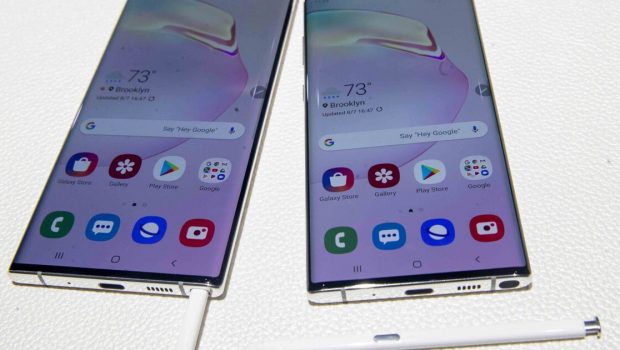Opinion: Aviation officials are worried about 5G technology. Why aren’t we?
Felicijan is a retired educator and president of the board of directors for the nonprofit Center for Electrosmog Prevention. She lives in Orange County.
The recent Federal Communications Commission/Federal Aviation Administration dispute over the of the launch of 5G is an example of things that make you go, “hmmm.” The FCC contends that 5G doesn’t interfere with airplane altimeters while the FAA is concerned 5G will obstruct accurate signals. Altimeters tell pilots their altitude from the ground. On Jan. 17, executives of several airlines sent a letter to federal agencies warning of a “catastrophic” aviation crisis if 5G was deployed near airports. I wondered, is 5G’s dramatic increase in radiofrequency radiation (electrosmog) safe?
The next day, several foreign airlines canceled some U.S.-bound flights due to the concerns over altimeter interference by 5G towers located by airports. Since then, the FCC and FAA have been evaluating and adjusting the frequencies of radio altimeters used by airplanes to conduct low-visibility landings where 5G is deployed. The FAA has approved 20 altimeters with plans to replace the rest. But is it enough?
We provide this platform for community commentary free of charge. Thank you to all the Union-Tribune subscribers whose support makes our journalism possible. If you are not a subscriber, please consider becoming one today.
Why did this 5G/aviation crisis develop? How could one industry be allowed to possibly jeopardize safety, at least according to officials at several airlines who would be in a position to know?
I questioned the mission of both agencies. The FAA mission statement was simple enough and read: “Our continuing mission is to provide the safest, most efficient aerospace system in the world.”
The FCC mission statement is “to make available, so far as possible, to all the people of the United States, without discrimination on the basis of race, color, religion, national origin, or sex, rapid, efficient, nationwide, and worldwide wire and radio communication service with adequate facilities at reasonable charges.” I thought, “Is this the FCC mission statement or the mission statement of the telecom industry?” Verizon’s mission statement reads, “We deliver the promise of the digital world to our customers. We make their innovative lifestyles possible. We do it all through the most reliable network and the latest technology.” These comparable mission statements could have been written by the same person. That changed my thinking.
I assumed that the FCC was protecting public safety as its primary mission. After all, the FCC tells us that wireless technologies are safe with no negative health effects. But protecting consumers and public safety is not the FCC’s mission. Safety is only one aspect of its “strategic” vision. Health and safety are an afterthought.
This explains why all four governing members of the FCC are seriously involved in promoting wireless technologies and not focused on the health or safety effects of 5G. The chair, Jessica Resenworcel, has developed policies to expand broadband and consistently supported wireless. Commissioner Brendan Carr’s bio indicates he is “the FCC’s 5G crusader.” Commissioner Goeffrey Starks supports expanding 5G nationwide through 5G infrastructure. Commissioner Nathan Simington was the senior adviser at the National Telecommunications and Information Administration, which focuses “largely on expanding broadband internet access.”
The FCC board has no commissioner committed to health and safety. Why? It should have at least one such member.
Could this explain why the FCC allowed telecom executives to deploy 5G with absolutely no testing on safety as discovered in testimony at a Senate hearing on Feb. 6, 2019?
This lack of concern about health and safety explains why the FCC lost its case in federal court on Aug. 13, 2021, at the U.S. Court of Appeals for the Washington, D.C. circuit. It ruled for the Children’s Health Defense, et al., against the FCC for failing to review 5G technology and noted it failed to provide any reasonable explanation as to why it didn’t review any current scientific evidence to support its standards.
Could it be that the FCC didn’t review current 5G scientific evidence of radiofrequency exposures because it would have raised questions that its 1996 standards are inadequate? Since 2007, the FCC has ignored evidence that radiofrequency radiation is harming the birds and bees that we depend on for food and a functioning ecosystem. Yet the FCC approved enough 5G satellites in space to cover 100 percent of the Earth with broadband access and also continuous 5G radiation, even though no nation state has the planetary authority to do so. The Outer Space Treaty of 1967 only ensures nation states consider the “province of all mankind” in considering satellite deployment. The FCC’s only responsibility is to ensure satellites in space don’t interfere with terrestrial communications. “Hmmm.”
In fairness, the FCC tries to say 5G shouldn’t be a problem because other countries like France don’t have altimeter issues. But the FCC is not comparing apples to apples to avoid the fact that France operates 5G at approximately half the power levels seen in the U.S.
If my plane is on descent, flying over mountains covered in heavy fog, I want a functioning altimeter and not just the pilot’s visual inspection. Don’t you?
There are too many health and safety issues surrounding 5G that need adequate review based on current science. Congress must change the mission of the FCC to promote health and safety and not lobby for telecoms.








Gloss